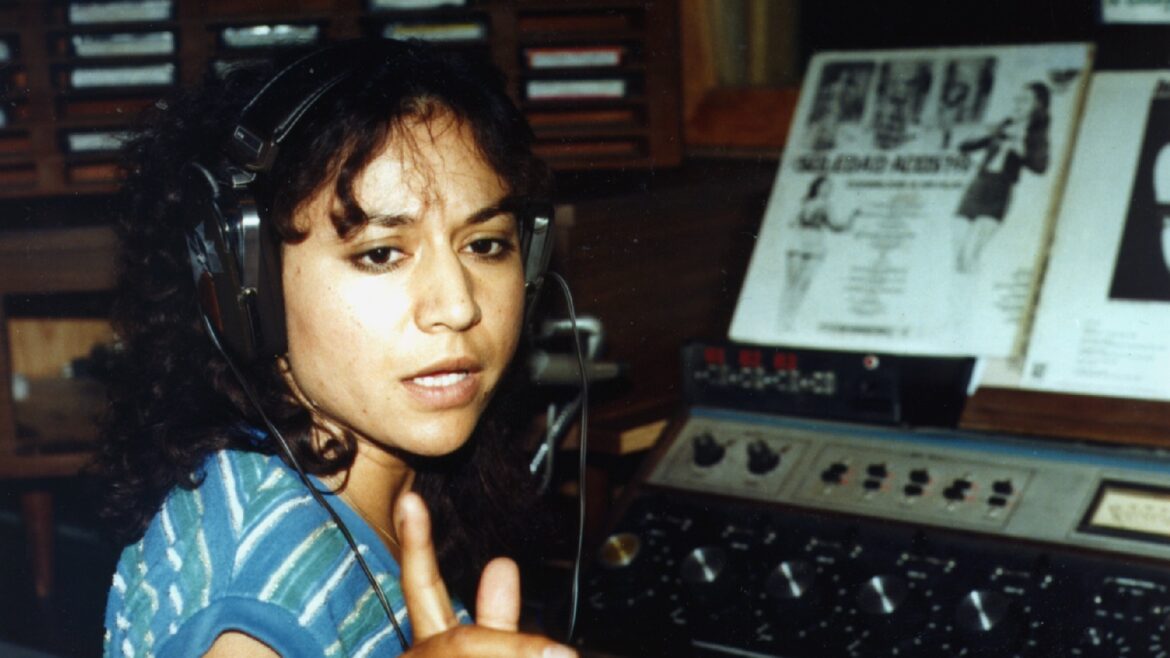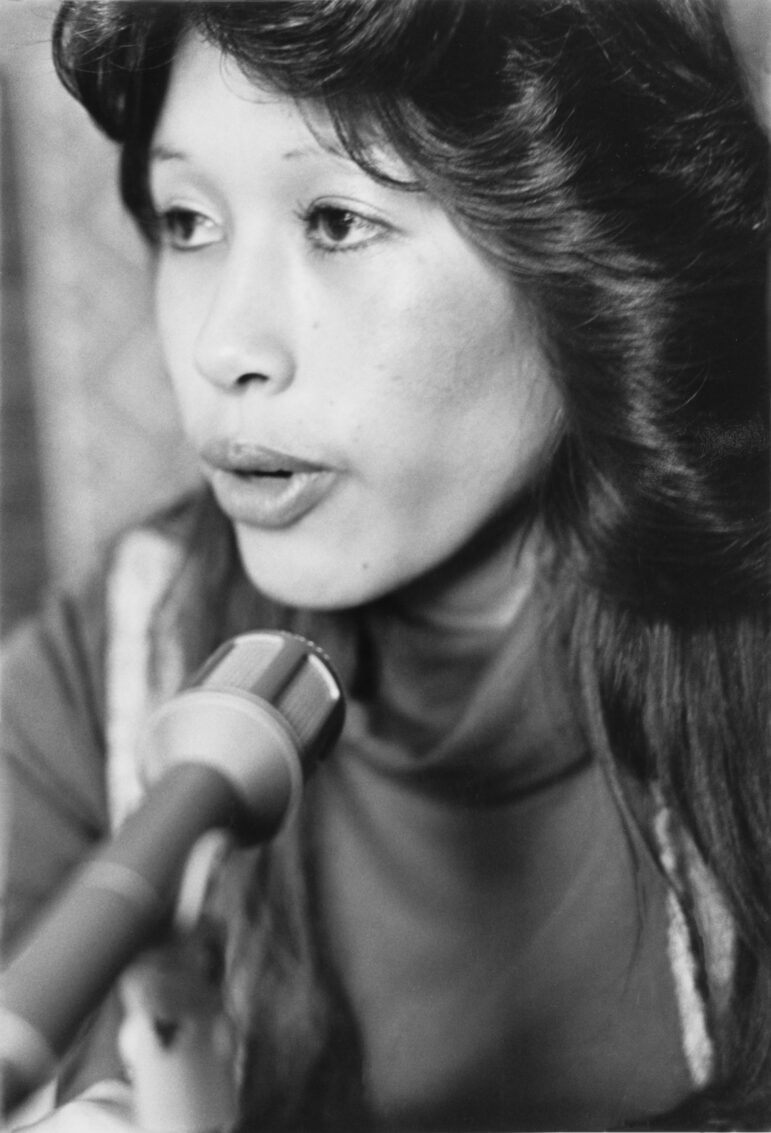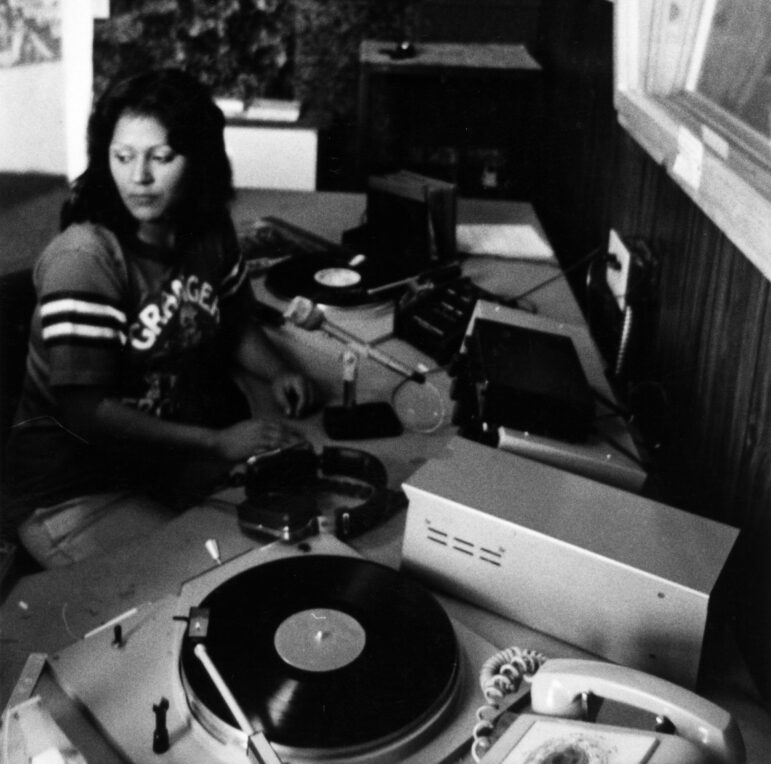How a Chicana-run community radio station changed the ‘cultural soundscape’ of public broadcasting

Courtesy of Rosa Ramón
Station manager Rosa Ramón on air in the Radio Cadena Studios in Granger, Wash., in a 1980s photo.
In the late 1970s and 1980s, public radio responded to the needs and interests of local communities often ignored or sidelined by commercial and mainstream media outlets. Radio Cadena, KDNA 91.9 FM, founded in 1979 in Granger, Wash., was one of many community radio stations founded in the 1970s by Chicana and Chicano activists in rural farmworker communities. KDNA served Mexican American and Chicano communities establishing roots in the Pacific Northwest. KDNA — pronounced in Spanish as cadena, meaning chain or link — connected Spanish-speaking farmworker communities across the region by producing culturally relevant radio broadcasts including public affairs programming, radio dramas, news and music. From educating farmworkers about the harmful effects of pesticides to empowering women to leave situations of domestic violence, KDNA quickly became a tool for community-building, advocacy and entertainment that was especially leveraged by the women who led it. In this excerpt from Feminista Frequencies: Community Building Through Radio in the Yakima Valley, Monica De La Torre centers the work of Chicana community radio broadcasters at KDNA, illuminating how women were able to make an impact into the male-dominated field of broadcasting.
For almost 10 years, I worked with KDNA’s first station manager, Rosa Ramón, in creating an archival record of the station’s many community broadcasting innovations. The Women of Radio KDNA, a 10-minute audio recording digitized and shared with me by Rosa, was produced for a women’s conference in 1984 that details the work of women at the radio station. The segment highlights three radio producers — María Estela Rebollosa (producer and on-air personality), Celia Prieto (public affairs producer) and Estella Del Villar (producer and music director) — with host and station manager Rosa Ramón, who takes listeners on a sonic walk-through of the Radio Cadena station studios. This recording was produced by Chicanas at Radio Cadena for a women’s conference in approximately 1984, providing much sonic evidence of women’s experiences in community broadcasting.
The program follows a day-in-the-life structure whereby audiences are introduced to KDNA’s daily operations through interviews with women station employees about their work and lives. The program sonically produces a distinct understanding of public broadcasting by centering the experiences of women community radio producers. It includes a breakdown of the radio production process as well as sound clips from KDNA radio programs produced by these broadcasters. The 10-minute segment ends with a call to other Chicanas to claim their voices by imagining themselves as radio producers working in communications, which Estella Del Villar notes “is a way of brotando del silencio (emerging from silence).” The fluidity of language and the seamless transition between English and Spanish imagines a bilingual audience that does not need translation. The women at KDNA offered insights into what it meant for Chicanas and Mexicanas to have access to the airwaves, while the audience learns about the actual labor in their detailed account of the radio production process.
Inspired by Chicana radio broadcasters’ collective process of producing community radio, I listened to the Women of Radio KDNA program various times alone and with a listening group I formed with colleagues.1 I gained access to this “sonic treasure” when Rosa Ramón digitized this radio segment from her personal archives.2 Upon opening the email that contained the sonic evidence we had searched for, I quickly downloaded the file and pressed play on my computer. The voices emerging through the digital speakers solidified my analysis of women’s community radio labor as Chicana radio praxis. As a radio producer myself, listening to the voices of Rosa Ramón, María Estela Rebollosa, Celia Prieto and Estella Del Villar from over 30 years ago was a reminder of the power of sound to transport listeners to a historical moment when Chicanas were carving spaces for themselves within public broadcasting. For the listener who is not the typically imagined media producer — working-class women, migrants and immigrants — there is power in hearing what exactly goes into making a radio program. By demystifying the production process, the program invites the listener to imagine herself as a radio producer. The program is a “how-to” of the production process that provides the tools to produce radio by laying out the steps involved in making a radio program, from writing and recording to editing the final radio version. This collaborative feminist praxis is integral to Chicana radio praxis, which promotes an inclusive ethos of radio making: “If I can produce radio, so can you.” Ramón’s leadership was instrumental in including women in the production process in addition to centering their concerns across all of KDNA’s programming.

In the recording, Celia Prieto explains, “The very first time I did the news live … I was very, very nervous, and after my news was over, I came out and Rosa and Estella were waiting for me at the door, and they were applauding me, and that made me feel really good because I get a lot of support from them and I think that’s what keeps me going.” Chicanas who stepped up to the microphone for the first time were not only hearing their own voices audibly broadcasted over public airwaves, they also were announcing the arrival of a sonically distinct Chicana public sphere. While Mexicanas and Chicanas have made important contributions to commercial radio broadcasting since its inception, radio in the 1970s was transformed with the ushering in of community-based public broadcasting, a format where Chicana producers thrived. For Chicana radio broadcasters like Celia Prieto, entry into community radio production was facilitated by a supportive environment of women learning side by side the basics of radio production and cheering each other on after completing a news segment. As Prieto powerfully acknowledges above, station manager Rosa Ramón’s and producer Estella Del Villar’s affirming applause “made me feel really good,” and their community of Chicana radio producers was a source of support and sustenance. This is one of the processes of Chicana radio praxis, macro- and micro-level interventions in radio broadcasting informed by Chicanas in leadership and production roles at community radio stations.
Working-class women of Mexican descent may not be the first population that comes to mind when the deployment of feminist tactics in community radio is considered. Yet at Radio Cadena, Chicanas altered the cultural soundscape of public broadcasting by creating Chicana-focused radio programs designed to reach farmworker women. The impact of radio programming by, for and about farmworker women extended beyond entertainment and into the realm of care. KDNA’s radio producers cared about their listeners’ health, well-being and livelihoods to the point that listeners would come to the radio station seeking help on everything from accessing migrant farmworker social services to finding a lost puppy or even purchasing a hog. Indeed, this form of connected and community-building radio production is the result of a Chicana radio praxis developed by the women of Radio Cadena. As leaders of emergent public radio broadcast stations, their model of community-based production included training women as producers and technical staff, programming for Chicanas and farmworkers — segments of the population that had not been addressed by mass media — and implementing antisexist radio station policies. With Chicanas at the helm at Radio Cadena, media production’s long-established borders of race, class and gender that had prevented women from learning the skills to be a producer, host or station manager were transgressed. This public broadcasting model centered on Chicana community radio producers who made inroads into highly selective, male-dominated public media structures while revolutionizing community radio programming.

To break into a male-dominated industry, Chicana broadcasters developed strategies of inclusion that, taken together, underscore a Chicana radio praxis. This not only presents a distinct model of activism and leadership, it adds new depth to the history of the Chicano movement and second-wave women’s activism by clearly delineating women’s involvement in community radio stations. Indeed, Chicana radio praxis stands at the intersection of these movements, audibly shifting our understanding of both. Chicana broadcasters crafted a radio praxis that centered critiques of gender at the intersections of race, ethnicity, class, citizenship and sexuality. These subjectivities were informed by their experiences as working-class Chicana migrant and Mexicana immigrant farmworker women. By intentionally passing the mic to Chicanas and Mexicanas in the Pacific Northwest, the Chicana radio praxis at KDNA moved them from margin to center and highlighted their unique experiences as migrant and immigrant women of Mexican descent in the Pacific Northwest.
Chicana radio producers, station managers, news directors and volunteers shaped a feminist consciousness at KDNA as they developed their own brand of on-air Chicana feminism. Chicanas at Radio Cadena imagined the radical possibilities of community radio broadcasting by actively including women not only as listeners but also as producers. Chicana radio broadcasters engaged in collective media practices that fostered a community of support for women producers. Women — armed with knowledge of how sexism and racism pervaded their lives — knew they needed collective action to ensure their equal participation in community radio.
Dr. Monica De La Torre is assistant professor of media and expressive culture in the School of Transborder Studies at Arizona State University, where her research and teaching practices bridge Chicana feminisms, Latinx feminist media studies, radio and sound studies, and women’s and gender studies. As a scholar practitioner of media and radio, she analyzes both content and production practices in articles and public scholarship published in WSQ: Women’s Studies Quarterly, New Review of Film and Television Studies, and Sounding Out!: The Sound Studies Blog. De La Torre’s first book, Feminista Frequencies: Community Building through Radio in the Yakima Valley, tracks the emergence of Chicano community radio in rural farmworker communities in the 1970s.
This essay appears as part of Rewind: The Roots of Public Media, Current’s series of commentaries about the history of public media. The series is created in partnership with the Radio Preservation Task Force, an initiative of the Library of Congress. Josh Shepperd, assistant professor of media studies at the University of Colorado Boulder, director of the LOC’s Sound Submissions Project and chair of the RPTF, is Faculty Curator of the Rewind series. Email: josh7759@colorado.edu
1. Thank you to the collective listening group of the Women of Radio KDNA segment: Ivette Bayo Urban, alma khasawnih, Noralis Rodríguez-Coss, and Miriam Valdovinos-Smith. ^
2. Chicana feminist scholar Maylei Blackwell’s own sonic treasure came from a recording of a radio program hosted by Chicana activist Irma Barrera. Blackwell reflects on the impact of listening to this recording: “As the recording played,” Blackwell describes with awe, “we heard the Chicano clap and the momentum building with a long litany of ‘Vivas!’ ” ¡Chicana Power!, 165. Just as this recording provided a new sonic understanding of the 1971 Conferencia de Mujeres por la Raza (Conference for Women of the People) in Houston, the Women of Radio KDNA program provides evidence of Chicana media practice and Chicana radio praxis. For more, see Blackwell, ¡Chicana Power!, 165. Maylei Blackwell, ¡Chicana Power! Contested Histories of Feminism in the Chicano Movement, 165. ^







